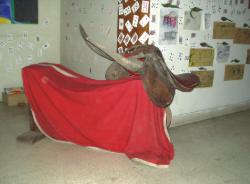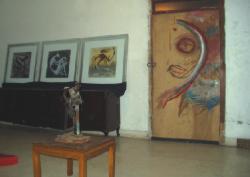| An
Arty Farewell
Srabonti
Narmeen Ali

Two
parallel lines of tiny clay lamps (diyas) lit the driveway,
welcoming people to the bi-annual Dhaka Longitudes Latitudes
art exhibition on Road 62, House 2 in Gulshan. The venue
was originally a two-storied house built in the 1970's.
Owners Boby and Pablo Khan are tearing the house down to
replace it with a condominium apartment complex. The exhibition,
lasting from October 10th to 15th, was their “farewell party”
to the house.
This
is Dhaka Longitudes Latitudes second exhibition this year.
The first one took place in April at an  apartment
complex, which was also being torn down, in Dhanmondi. Because
the exhibition took place right in the middle of the Iraq
War, a lot of the artwork featured anti war sentiment. However,
there was no specific theme involved in either of these
exhibitions, in order to encourage freethinking and individuality. apartment
complex, which was also being torn down, in Dhanmondi. Because
the exhibition took place right in the middle of the Iraq
War, a lot of the artwork featured anti war sentiment. However,
there was no specific theme involved in either of these
exhibitions, in order to encourage freethinking and individuality.
Organisers
Humayun Kabir, Anam Biswas, Jayanta Halder and Shehzad Chowdhury
spent over two months planning the event and the installation
of all the art contributions and the decoration of the house
took about two days.
Shehzad
Chowdhury, artist and curator, comments, “The idea is to
get the community involved. We are celebrating the end of
the building…our goal is that we are trying to get a platform
for different creative individuals, be they artists, musicians,
painters, or filmmakers.”
The
“platform” consisted of artistic expressionism in every
corner. The lone guards' room at the gate entrance showed
a snake-like string of skulls. Downstairs, a throng of people
swayed to the rhythm and beats of the various bands playing
in a corner room, also decorated with paintings and collages
bearing messages about war and peace. Musicians who had
never played together before got together and “jammed,”
adding to the improvisational and impromptu feel of the
exhibition. A lonely face stared across the room towards
the graffiti against war on the opposite wall. An abstract
mini exhibition of HIV/AIDS lay in the far corner with metal
wires designed to signify the virus itself. Cards where
glued onto every open space imaginable, including the banister
of the stairs and the floors. The walls around the stairway
held  pictures
of different scenes from Bangladesh. A portrait of a woman
in a sari stood in front of gleaming clay pots decorated
with glitter and paint. Doodles on anything ranging from
scrap paper and envelopes to receipts added to the informal
but overall “passionate about arts” ambience. pictures
of different scenes from Bangladesh. A portrait of a woman
in a sari stood in front of gleaming clay pots decorated
with glitter and paint. Doodles on anything ranging from
scrap paper and envelopes to receipts added to the informal
but overall “passionate about arts” ambience.
“Art
is open to interpretation and it is interactive,” says Chowdhury.
“It brings out who the artist is and allows them to share
themselves with the world: their own socio-economic background,
culture, ideals, relation to media, etc.”
There
was no money involved in this exhibition. The artists and
performers all contributed their work free of charge. Most
of the artwork was from independent artists, although some
students from various institutes, including the Charukala
Institute of Art in Dhaka also contributed. “We tried not
to make the exhibition so institutionalised in that sense,”
says Chowdhury. “The only criteria is that all the artists
are based in Dhaka. People bring things in every day for
us to put in the exhibition.”
Young
artists in Dhaka do not ordinarily have a non- institutional
environment that encourages them to express themselves so
freely. It is not very often that they find spaces such
as this, which give them the opportunity to lose themselves
in their passion: art. institutional
environment that encourages them to express themselves so
freely. It is not very often that they find spaces such
as this, which give them the opportunity to lose themselves
in their passion: art.
Says
organiser and guitarist Anam Biswas, “It's all about creating
a free space for these artists. They need space -- both
psychical and psychological -- for individual growth. Dhaka
does not really give people our age who are artists such
a space. We wanted to encourage these artists to find a
space to experiment and express themselves, and give them
a voice. What makes it even better for them is that there
is an exchanging of ideas. The exposure of one person's
idea can trigger another person's work.” | 

 apartment
complex, which was also being torn down, in Dhanmondi. Because
the exhibition took place right in the middle of the Iraq
War, a lot of the artwork featured anti war sentiment. However,
there was no specific theme involved in either of these
exhibitions, in order to encourage freethinking and individuality.
apartment
complex, which was also being torn down, in Dhanmondi. Because
the exhibition took place right in the middle of the Iraq
War, a lot of the artwork featured anti war sentiment. However,
there was no specific theme involved in either of these
exhibitions, in order to encourage freethinking and individuality. pictures
of different scenes from Bangladesh. A portrait of a woman
in a sari stood in front of gleaming clay pots decorated
with glitter and paint. Doodles on anything ranging from
scrap paper and envelopes to receipts added to the informal
but overall “passionate about arts” ambience.
pictures
of different scenes from Bangladesh. A portrait of a woman
in a sari stood in front of gleaming clay pots decorated
with glitter and paint. Doodles on anything ranging from
scrap paper and envelopes to receipts added to the informal
but overall “passionate about arts” ambience.  institutional
environment that encourages them to express themselves so
freely. It is not very often that they find spaces such
as this, which give them the opportunity to lose themselves
in their passion: art.
institutional
environment that encourages them to express themselves so
freely. It is not very often that they find spaces such
as this, which give them the opportunity to lose themselves
in their passion: art.